astro.wikisort.org - Meteorite
Proxima Centauri d (also called Proxima d) is a candidate exoplanet orbiting the red dwarf star Proxima Centauri, the closest star to the Sun and part of the Alpha Centauri triple star system. Together with two other planets in the Proxima Centauri system, it is the closest known exoplanet to the Solar System, located approximately 4.2 light-years (1.3 parsecs; 40 trillion kilometres; 25 trillion miles) away in the constellation of Centaurus. The first signs of the exoplanet emerged as a weak 5.15-day signal in radial velocity data taken from the Very Large Telescope during a 2020 study on Proxima b's mass. This signal was formally proposed to be a candidate exoplanet by Faria et al. in a follow-up paper published in February 2022.[2][1]
 Artistic depiction of Proxima Centauri d, with Proxima Centauri and Alpha Centauri A & B visible in the background | |
| Discovery[1] | |
|---|---|
| Discovery site | VLT-ESPRESSO |
| Discovery date | 2020 |
Detection method | Radial velocity |
| Orbital characteristics[1] | |
Semi-major axis | 0.02885+0.00019 −0.00022 AU |
| Eccentricity | 0.04+0.15 −0.04 |
Orbital period (sidereal) | 5.122+0.002 −0.0036 d |
| Semi-amplitude | 0.39±0.07 m/s |
| Star | Proxima Centauri |
| Physical characteristics[1] | |
Mean radius | ≙0.81±0.08 R🜨 |
| Mass | ≥0.26±0.05 M🜨 |
| Temperature | 360 K (87 °C; 188 °F) |
Proxima d is a sub-Earth at least one-quarter of the mass of Earth (or twice the mass of Mars), orbiting at roughly 0.029 AU (4.3 million km; 2.7 million mi) every 5.1 days.[2] It is the least massive and innermost known planet of the Proxima Centauri system. It is the least massive exoplanet detected with the radial velocity method as of 2022[update]. Proxima d orbits too close to its star to be habitable, and receives about 190% of Earth's irradiation—assuming an Earth-like reflectivity, its equilibrium temperature may reach 360 K (87 °C; 188 °F).[1]
See also
References
- Faria, J. P.; Suárez Mascareño, A.; et al. (January 4, 2022). "A candidate short-period sub-Earth orbiting Proxima Centauri" (PDF). Astronomy & Astrophysics. European Southern Observatory. 658: 17. arXiv:2202.05188. Bibcode:2022A&A...658A.115F. doi:10.1051/0004-6361/202142337.
- Suárez Mascareño, A.; Faria, J. P.; et al. (11 May 2020). "Revisiting Proxima with ESPRESSO". Astronomy & Astrophysics. 639: 24. arXiv:2005.12114. Bibcode:2020A&A...639A..77S. doi:10.1051/0004-6361/202037745. ISSN 0004-6361.
На других языках
- [en] Proxima Centauri d
[ru] Проксима Центавра d
Проксима Центавра d — неподтверждённый кандидат в экзопланеты у красного карлика Проксима Центавра, третья по времени открытия экзопланета в системе ближайшей к Солнцу звезды. Если её открытие подтвердится, она станет одной из трёх известных ближайших к Земле экзопланет, а также одной из первых известных миниземель.Другой контент может иметь иную лицензию. Перед использованием материалов сайта WikiSort.org внимательно изучите правила лицензирования конкретных элементов наполнения сайта.
WikiSort.org - проект по пересортировке и дополнению контента Википедии


